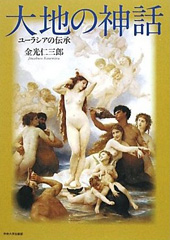Top>OpinionCarnivore Women and Herbivore Men in Mythology
 Index
Index

Jinzaburo Kanemitsu [Profile]
Carnivore Women and Herbivore Men in Mythology
Jinzaburo Kanemitsu
Professor, Faculty of Economics, Chuo University
Areas of Specialization:
Mythology and French Literature
Carnivore Women: Of Today and the Past
In recent years, the popular phrases: carnivore women and herbivore men have emerged to describe the phenomenon of the reversal of the traditional roles of men and women in Japanese youth culture, and they have become popularized in the world of journalism. In a language class in the Faculty of Economics 30 years ago, it would have been quite normal for there only to have been 3 or 4 female students in the class. However, in recent times, there is always a great turnout of women, with most classes having 10 or more female students. It can be said that this shows just how far female students have come in achieving democratization of opportunity, so that they can stand shoulder to shoulder with their male counterparts. But it is also the case that the classroom scenes that we used to see, in which the minority of female students dominated and took the lead in class, have become a much less common occurrence. So were the real carnivore women those of the old days, with their strong sense of awareness of being an elite minority? Or are the real carnivore women the female students of today, who, although they have been immersed in the masses, are using the power of the masses as their own, and are unconsciously thrusting forward using that power?..It is hard to say.
The Earth Goddess of the Eurasian Continent

Last year, I published a book entitled, “The Mythology of the Earth: The Lore of Eurasia (Daichi no Shinwa - Yuurashia no Denshou),” (Chuo University Press) which traces the lore of the Earth Goddess in the Eurasian continent. Venus, the Roman goddess, is the goddess of love and fertility. When one traces back the origins of the image of Venus, one reaches the Greek goddess Aphrodite, Phoenicia Ugarit's Ashtart, and Mesopotamia's Ishtar. It is clear from the fact that both Ashtart and Ishtar have the same sound—shtar-embedded in their names that, although there may be some regional variation, they refer to the same goddess of Asia Minor. In the city of Paphos on the island of Cyprus, there is a temple dedicated to Ashtart. Another of Aphrodite's names is Cyprus, and there is a strong tradition of goddess worship evident on the island of Cyprus. Ashtart came to Greece from Pheonicia and became Aphrodite, the goddess of love. In this sense, both the goddess Aphrodite of the Greeks and the goddess Venus of the Romans were derived from Mesopotamia's Ishtar (also known as Inanna). There are countless different goddesses to be found in all the different regions of the world, but it appears that for the most part there was one main stream which formed the root or source for the creation and diffusion of the image of various different goddesses across the Eurasian continent.
Fighting Goddesses and their Relevance to Modern Carnivore Women
Ishtar was not only the basic model for Aphrodite, as a goddess of love and fertility, but she was also a great goddess who combined the earth goddess characteristics of Demeter and the fighting virgin characteristics of Artemis and Athena. Ishtar was born bearing the weapons used by gods even as she emerged from her mother's womb. She later became known as the Fighting Lady and was able to defeat innumerable enemies. This image of the fighting goddess appears in many instances in Greek mythology alone: there is the virgin goddess of hunting, Artemis, as well as the goddess to defend Athens, Athena, and later there is also the emergence of the tribal group of fighting women, the Amazons, who worship Artemis. But it also seems that the effects of her image have spread in the creation of other powerful female figures. These include such figures as the Northern European myth of the group of fighting women, the Valkyrie; the queen Medb in Celtic mythology, who was strong enough to defeat many men; and Guinevere, the wife of King Arthur, who presided over meetings of the Round Table and controlled the group of warrior Knights, and other such figures. This goes to show just how prevalent carnivore women have been among the goddesses of the world. It can be supposed that these goddesses of love and war were created to embody the hopes of the people for great productivity and fertility in terms of hunting and agriculture, and so they are also quite free-spirited in terms of matters of love too.
Herbivore Men Gods Known as Cultural Heroes
Among the stories that have survived relating to Ishtar, there is a myth of her descent into the Underworld. Not only did she descend into the Underworld herself, she had previously condemned her lover, Dumuzi, to the Underworld herself. If the goddess of love descends into the Underworld and is judged to have the look of death, all love will disappear from this world and the earth will not be productive. The water god, Ea, sends a messenger to the Underworld to sprinkle Ishtar's corpse with the water of life to bring it back to life, and in exchange for bringing her back from the Underworld, her lover Dumuzi has to spend half the year in the Underworld as a seed, and can spend the other half of the year above ground with Ishtar. This story became integrated with the natural seasonal changes of the earth and spread as the myth of the descent of the goddess of love to the underworld and the origin of seasonally changing vegetation. In this myth not only the goddess but also the dead god (hero) are brought back to life, or we anticipate them being brought back. As well as relating to the stories of Adonis, Dionysus, and King Arthur, this could also be expansively interpreted as relating to the story of Christ. The gods (heroes) in these stories are herbivore men in cases where the goddess in the couple is a carnivore woman, and take on a stronger personality when the goddess is weak. But they also have the common feature that they spread across agriculture, military matters and religion, etc. In mythological studies they are known as cultural heroes.
Cultivation as the Root of Culture
In French as well as English, the word culture has the meaning of cultivation (as in agricultural cultivation), in addition to the more common meanings of culture and development by education. It seems like the etymological root of culture implies that just as the earth goddess is the personification of the Earth which must be cultivated in order to ensure fertility and productiveness and any degree of production at all, it is not really possible to cultivate culture or achieve development by education. In fact, it was by allowing themselves to fully become the seeds of goddesses that the gods were able to finally bloom themselves, and thus to become cultural heroes. Today's young people seem to be moving further away from cultivation. It is not possible to cultivate without coming into contact with others, and love and culture can only arise from interchange and exchange. Virtual cultural phenomena today seem to be forcing young people into isolation. but then I am writing this after sitting for a long time in front of my own computer, so I am not really in a position to say very much.
- Jinzaburo Kanemitsu
Professor, Faculty of Economics, Chuo University
Areas of Specialization: Mythology and French Literature - Jinzaburo Kanemitsu was born in 1941. He graduated with an undergraduate degree in French Literature from Tokyo University's Faculty of Letters in 1964. He received a Master's Degree from Tokyo University's Graduate School of Humanities and Sociology in 1966. His areas of specialization are French literature and comparative mythology. He is currently Professor on the Faculty of Economics at Chuo University. His published works in Japanese include, “The Tragedies of Racine (Rashiine no Higeki),” and “The Mythology of the Earth (Daichi no Shinwa),” (both published by Chuo University Press); “The Primordial Landscape and Symbols (Gensho no Fuukei to Shinboru),” and “Eurasia's Creation Myths (Yuurashia no Sousei Shinwa)” (both published by Taishukan Shoten); and “Mythologies of Love and Death (Ai to Shi no Shinwa),” (published by Shinbi-sha). His edited works and supervising editor works include, “Heroes and Monsters of Legend (Densetsu no Eiyuu to Monsutaa),” “The Goddesses, Nymphs, and Women Demons of the World (Sekai no Megami, Tennyo, Kijo)” (both published by Seitosha). His translated works include, Jean Chevalier, ed., “Dictionnaire des Symboles,” (as representative translator), and Yves Bonnefoy ed. “Dictionnaire des Mythologies,” (as principal translator) (both of which were published by Taishukan Shoten, and both were awarded the 33rd and 37th Japan Translated Publications Literature Prize, respectively), among many others.
- Research Activities as a Member of Research Fellowship for Young Scientists (DC1), Japan Society for the Promotion of Science (JSPS) Shuma Tsurumi
- Important Factors for Innovation in Payment Services Nobuhiko Sugiura
- Beyond the Concepts of Fellow Citizens and Foreigners— To Achieve SDGs Goal 10 “Reduce Inequality Within and Among Countries” Rika Lee
- Diary of Struggles in Cambodia Fumie Fukuoka
- How Can We Measure Learning Ability?
—Analysis of a Competency Self-Assessment Questionnaire— Yu Saito / Yoko Neha - The Making of the Movie Kirakira Megane








